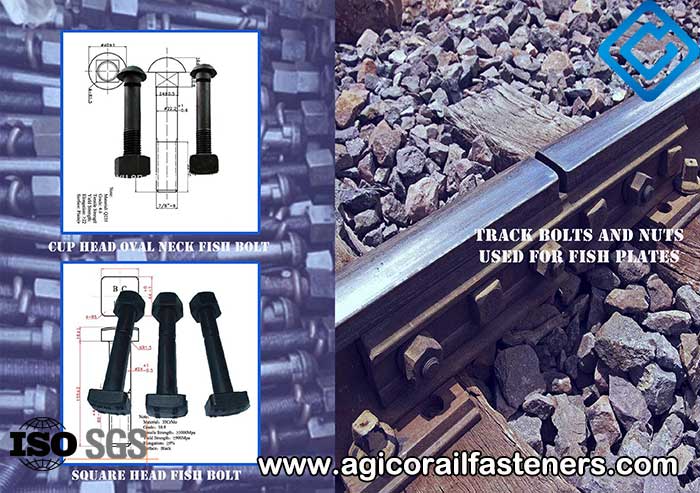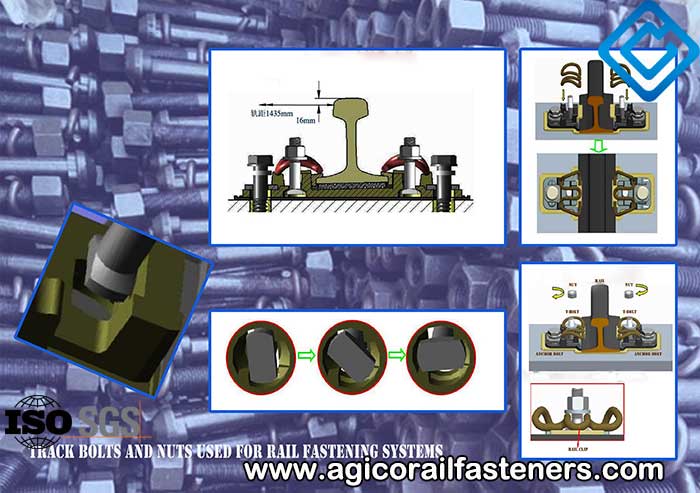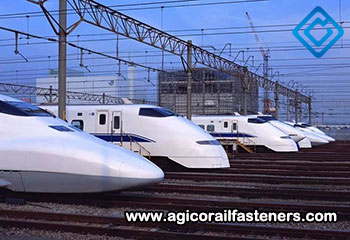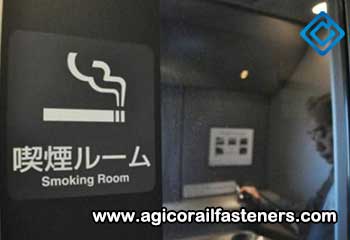The Combination Of Bolts And Nuts Plays A Very Important Role In Joining Rail And Fastening Track
Track Bolts and Nuts in Joining Rail and Fastening Track
Track bolts and nuts are very crucial railway fasteners. The combination of bolts and nuts plays a very important role in joining rails and fastening track. Specifically, the combination of track bolts and nuts are generally used for:
- A. Connecting and fastening fish plates through their holes to make two pieces of steel rails jointed together;
- B. Being as the components of railway fastening system to connect and fasten rail and rail clip (Or rail blade, rail clamp) or rail tie plate and rail sleeper.
They are often used in pairs, sometimes with washers or plastic dowels when needed, for the reinforcement of railway track. Common types of bolts in the railway system are square head fish bolt, cup head oval neck fish bolt, BHON track bolt, T bolt, anchor bolt and so on.
Track Bolts and Nuts Used for Fish Plates
The track bolts and nuts used for fishplates are the railway products that are extensively used in the construction of railway track. They are very easy to use and less expensive. A huge large number of bolts and nuts are used.

Type and material for bolts and nuts
Their types include: Φ14×70, Φ16×75, Φ18×90, Φ20×90, Φ22×135, Φ24×135, Φ24×145 and Φ24×170 and so on. They are usually made by the friction press thermoforming machine. The bolts are 50mm in length. Some are made by the method of the cold heading forming. The material is generally Q235 steel, 45# steel or others.
Installation of bolts and nuts
As connecting the rail manually, the workers use crowbars to shift the rail from the road side to the shoulders on rail sleeper first. And then install fish plates, bolts and washers according to the calculation of the reserved rail joints and tighten the nuts according to the specified torque. The bolt heads on fish plates shall not be placed on the same side of the rails. Generally, the bolt heads on both sides shall be placed on the inner side of the rails (By the side of the rail center line). The middle bolt heads shall be done on the outer side of the rails. The fish plates shall be close to the rails. After finishing the installation of one side rail, fix the other side rail as specified the gauge distance. And then, correct them and fill the slag in the gap between the sleepers. According to the benchmark, the workers will raise the track up to the standard height.
As installing, the workers should insert a wrench tip to the second hole of the fish plate, and then drag the fish plate to get close to the steel rail. Next, the wrench should be inserted into the corresponding rail hole, and then the second corresponding fish plate should be also inserted in the wrench. Afterwards, the workers make two fish plates keep close to the rail at the same time. Before using the bolts, the workers should check whether the holes of the fish plates are in right places. The nuts should be fixed on the inside and outside the railway line in a cross way to prevent the bolts are all cut off by the train wheels as the train derails. Rail gap should be reserved and adjusted according to the design. When tightening the bolts, the workers’ feet should stand on the same side of the bolt heads. The toes step on the edge of the fish plate and the body should bent forward, and then the workers can clench the wrench until all are finished, and then tighten them again. The places where the rail joints between bolts and fish plates should be oiled. The washers’ openings should face downwards. The bolt torque shall be not less than 600Nm. When installing fish plates, the workers should use metal tools. It is prohibited to use the fingers to keep alignment of bolt holes.
Square head fish bolt and cup head oval neck fish bolt are usually seen on the track. We are very familiar with them.
Track Bolts and Nuts Used for Rail Fastening Systems
Track bolts and nuts are often used as the components on rail fastening systems. There are two main types, namely, anchor bolts and T-bolts. Anchor bolts are used to fasten rail tie plates and rail sleepers. T-bolts and nuts are mainly used to tighten rail clip (Or rail blade, rail clamp) to help tighten rails.
In China, anchor bolts and T-bolts have been ever used on 67 arch blade type fastening system, DT-III-2 type fastening system, WJ-2 type fastening system, TF-Y type fastening system, Type II fastening system and WJ-1 type small resistance fastening system and others.
WJ-1 type small resistance fastening system is used mainly for Jiujiang Yangtze River Bridge. DT-III-2 type fastening system is mainly used in China's subway system.

Now we will take WJ-7 type fastening system for example to describe main installation procedures of T-bolt. Inserting T-bolt head into the bottom of the tie plate and rotating by 90°, then lift the T-bolt head completely into the groove. The specific processes are as follows:
- A. According to the design angle of the tie plate as shown, T-bolt head shall be inserted into the tie plate;
- B. After T-bolt head is inserted into the tie plate, T-bolt shall be turned 90° clockwise till its head reaches the intended location;
- C. Rail clip shall be placed here;
- D. And then flat washer shall be right placed. Next, tighten the nut. As tightening the nut, the threaded part of T-bolt shall be coated with oil beforehand;
- E. Tighten rail clip till its middle part contacts with and insulator.
Anchor bolts and T-bolts have ever been used in German SKL 300 fastening system, Cologne blade fastening system and Locke fastening system, etc.
For example, SKL 300 fastening systems include Ss Series bolts and nuts. Among them, the total length of standard Ss36-230 bolt of 300-1 type fastening system is 230mm. In order to increase the needs of the rail adjustment, it is also equipped with Ss36-240, Ss36-250, Ss36-260, Ss36-270 and Ss36-280 bolt. 300-1 type fastening system adopts a direct type. Steel rails are laterally supported by the baffles. The rails are always pressed together by two Skl15 clips that are secured by the bolts in the plastic dowels in the concrete sleepers. As tightening the bolts, the workers shall use the supplied socket wrench (pipe wrench) to work with a torque of 30-50Nm. Prior to installation, the workers should add 10-15 grams of lubricant (Ferrocoat 673FS, Elascon KGF) to the holes in the sleepers.
AGICO Group owns rich experience and advanced equipments in railway accessories. As a professional railway enterprise, AGICO Group is major in railway products with good quality. We have steel rail, crane rail, rail fastening systems, rail fishplate, rail tie plate, rail bolt, railroad spikes. Besides, we can manufacture Square head fish bolt and cup head oval neck fish bolt. We are a professional bolt and nut design and manufacturer. We can manufacture track bolts and nuts according to different standards and sizes. The surface of the product supports different processes, and every detail can meet your needs. Depending on more than ten years export experience, we can offer the most competitive price and highest quality for our customers all over the world. We sincerely seek for reliable cooperators abroad to market the world. Welcome to contact with us!
We receive enquiries in English, Español (Spanish), Русский язык (Russian), Français (French) and العربية (Arabic). Our professional team will reply to you within one business day. Please feel free to contact us!



